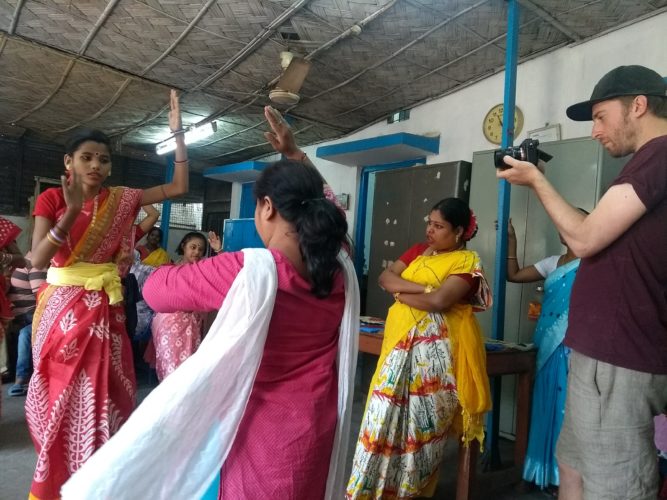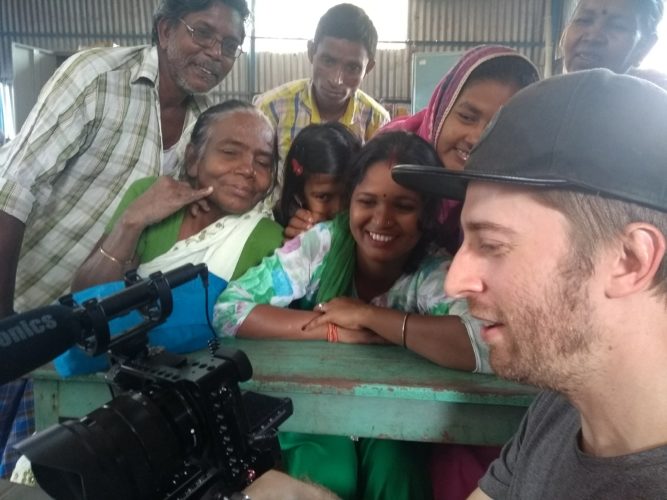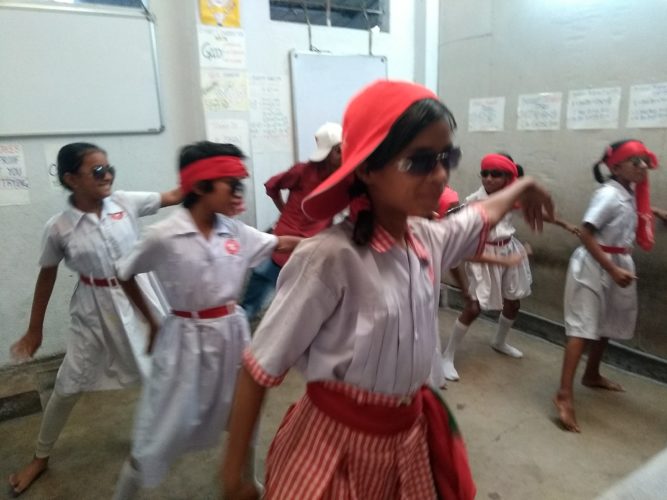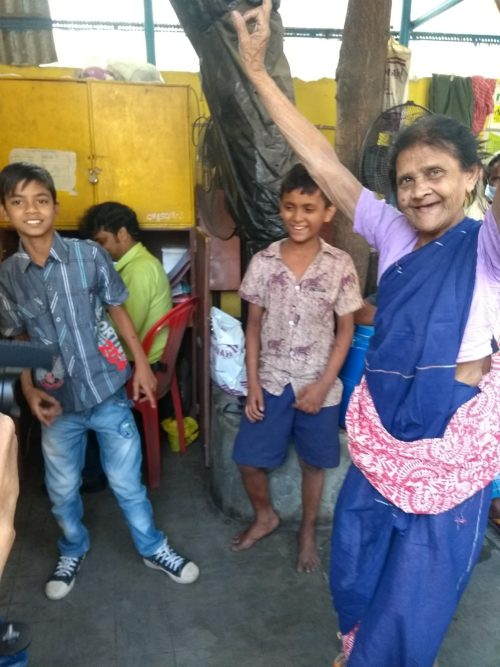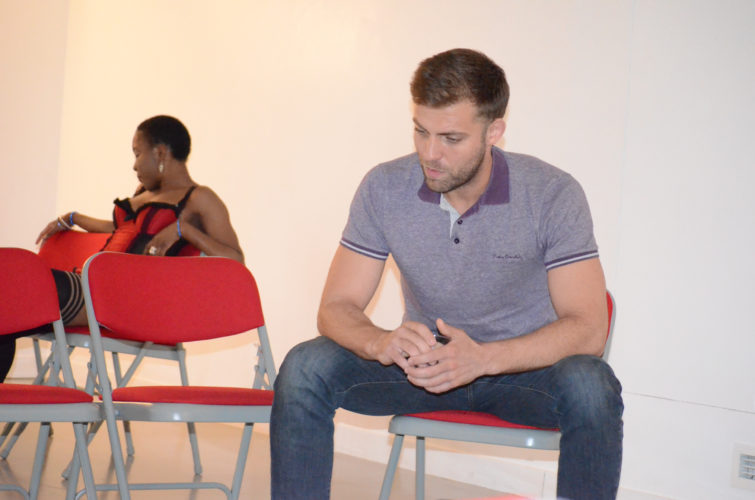How crazy is that! Filming #theworldscraziestdancevideo
By Sean Duggan
Where does inspiration come from?
For the past 27 years I have supported Calcutta Rescue, a small charity in Kolkata, India, which provides healthcare and education for thousands of the poorest people in the city’s teeming slums. I have edited its newsletter in the UK for most of that time, written hundreds of articles about its work and organised social events, sleep-outs, and even a fire-walk to raise money for it. But I am always on the lookout for new ways to get its name known, so more people will support it and we can help more of those in such dire need.
Last November inspiration struck when I received a phone call from my friend Isabelle, who runs a support group for the charity in the German-speaking part of Switzerland. She had just got back from Kolkata and told me she had been in its TB clinic one day when two women were told they were finally clear of the disease, which kills 300,000 people a year in India. They were so delighted that they danced for joy in the middle of the clinic - to the amazement of staff and patients.
As a journalist I immediately recognised the power of that image, that story. At first, I thought I would write about it. But then, after I discovered that a British photographer who supported Calcutta Rescue was going to be in the city in March, at the same time as me, I had another idea. What if we could shoot a video of people dancing for joy at all of Calcutta Rescue’s projects? Even I thought it was crazy at first - but the more I thought about it, the more I wanted to do it.
The unspoken, but pervasive, view of the charity’s work is that it is worthy but unremittingly depressing, and the people it helps are downtrodden victims. How can that not be the case when its clinics and schools are located in some of the worst slums in India, dealing with some of the most disadvantaged people, some suffering from diseases such as TB and leprosy?
But my own experience briefly running a clinic there in the early 90s, and on subsequent visits to the projects, was that, despite all the manifest challenges, staff and patients show remarkable resilience and appreciate even the smallest manifestation of good-fortune. Every day there are situations that spark humour and happiness. If we could capture that spirit in a film, maybe we could shift those preconceptions just a few inches… And such an innovative approach could expose thousands more people to Calcutta Rescue’s amazing work.
But when I got to Kolkata in February to start preparations for filming, I began to seriously doubt the sanity of my muse.
First, we would have to brief a dozen teams, get their buy-in to the project, and get them rehearsing some dance moves. Then we would have to film at 12 different locations around the city in just eight days - from a pharmacy and a storeroom to schools, a leprosy clinic and a mobile ambulance. All these places were cramped and crammed. There was not enough space to swing the proverbial cat, let alone deploy a film crew. Just getting around the city on its over-crowded streets is difficult enough, and the temperature was already a sweltering 36C. It was also very clear staff had much more important things to do with their time, and who knew how the patients would react?
The omens looked even more unpromising when the charity’s founder, Dr Jack Preger, now 87 and famously publicity-shy, refused to appear in the film, claiming that the place where I wanted to film him, on the roof of the charity’s school where he lives in the middle of a red-light district, was unsafe and might collapse if anyone danced there (turns out this is true!). On top of that, neither photographer and musician Jake Roos nor I spoke a word of Bengali or Hindi. So, when Jake arrived in town a few weeks later, I had to work hard not to show just how apprehensive I was about us actually pulling this off.
Fortunately, we were lent the services of the charity’s very able media assistant, Suchandra Chatterjee, as translator and fixer. Without her this project would have sunk without trace. Even with all her help, and with the unwavering professionalism and high-spirits of Jake, the filming proved to be a gruelling ordeal. By 4pm on the first day, I was absolutely exhausted.
We were at the charity’s fairtrade handicraft project shooting a complex dance routine, that started in the office, then involved a series of craft workers making specific movements in sequence, before everyone formed a circle outside and waved multi-coloured scarves in the air. I had lost count of the number of takes we had shot, with no end in sight. Either something went wrong with the routine inside, or there was some unforeseen intrusion when we were filming in the street. A neighbour walked through the circle carrying a handful of washing then a mangy, flea-bitten, street dog chose that very spot to lie down and chew on its buttocks.
Later, at the charity’s biggest clinic, Tala Park, I nearly got several fingers chopped-off when testing whether metal benches could take the weight of dancing patients. I was up on one, jumping around, when my right hand collided with the blade of a rusty metal ceiling-fan, spinning at maximum speed. Shock prevented me from feeling any pain at first, but the spray of blood across the opposite bench made clear that I had not escaped unscathed. Fortunately, I was in the very best place to have such an accident. The team there is very used to treating people with appalling injuries from fires and collisions in the street. So, within a minute, I was being treated by a team that consisted of a doctor, the senior medical manager at the charity, and two highly experienced dressings nurses. Far more than was strictly needed for a couple of cuts to my hand - but hugely reassuring.
Over that week we met some unforgettable people. The woman who was rejected by her family, and then knifed and beaten by her husband, when they found out she had had leprosy. The 90-year-old granny who insisted on coming to a clinic to dance for us, despite having a hip operation only a month before. A teenage boy, orphaned when he was very young, who found his sense of belonging and worth through football. A young mother who, with the help of the charity’s staff, has stood strong in the face of insults and assaults by neighbours, who banned her from using the slum’s shared toilet because she has multi-drug-resistant TB.
They, and hundreds more students and patients, were more than happy to dance for us. When we arrived at each clinic or project we explained what we were doing, and why, and made clear that no one had to take part or be filmed. But almost everyone wanted to, and afterwards the atmosphere of excitement and happiness was palpable - reward enough for all our efforts.
For those few minutes of filming they felt like they were in the spotlight, that they really mattered, that the world out there - about which many have only a very sketchy understanding - was looking at them. A brilliant soundtrack, Living in the City by British artist Rhys Lewis, who let us use it for free, and great camerawork and editing by Jake, mean that the film stands in its own right as a powerful and upbeat music video.
More than 15,000 people watched the film in the first week that it was posted on YouTube and Facebook. Sometimes the craziest ideas can actually work, if you believe in them enough...
FΩRMIdea London, 27th May 2018.
For more information, please visit www.calcuttarescue.org
